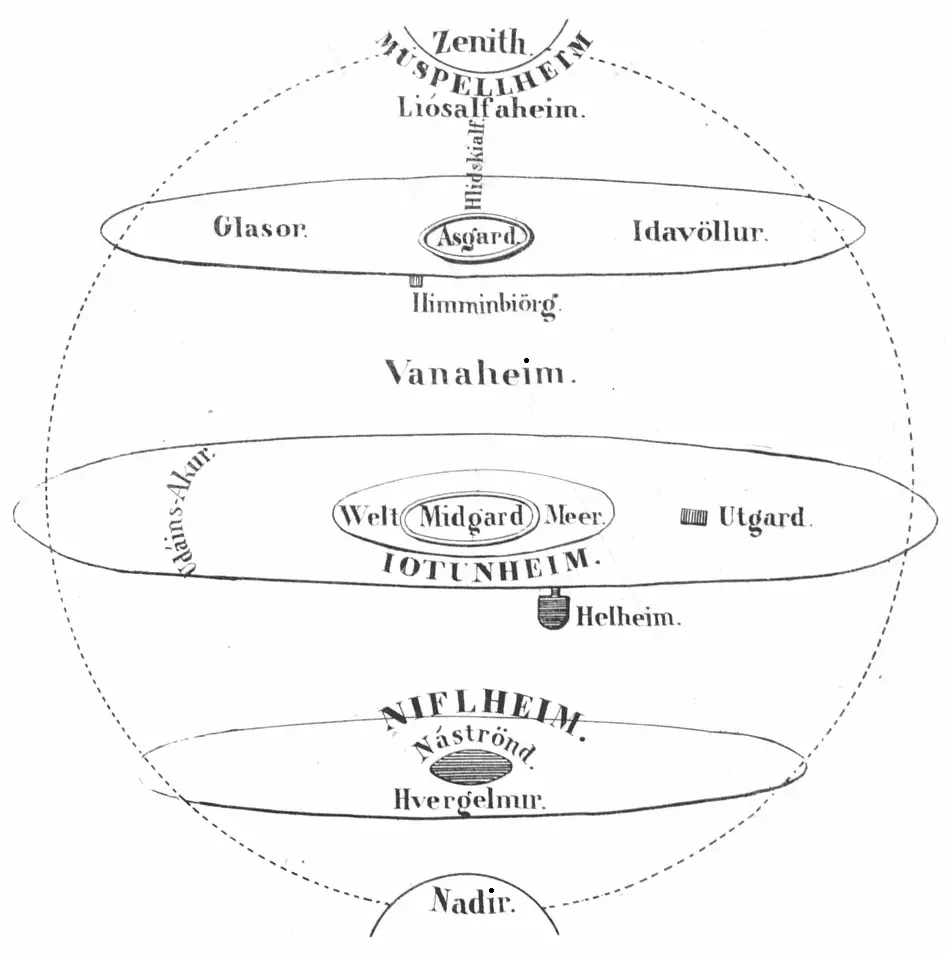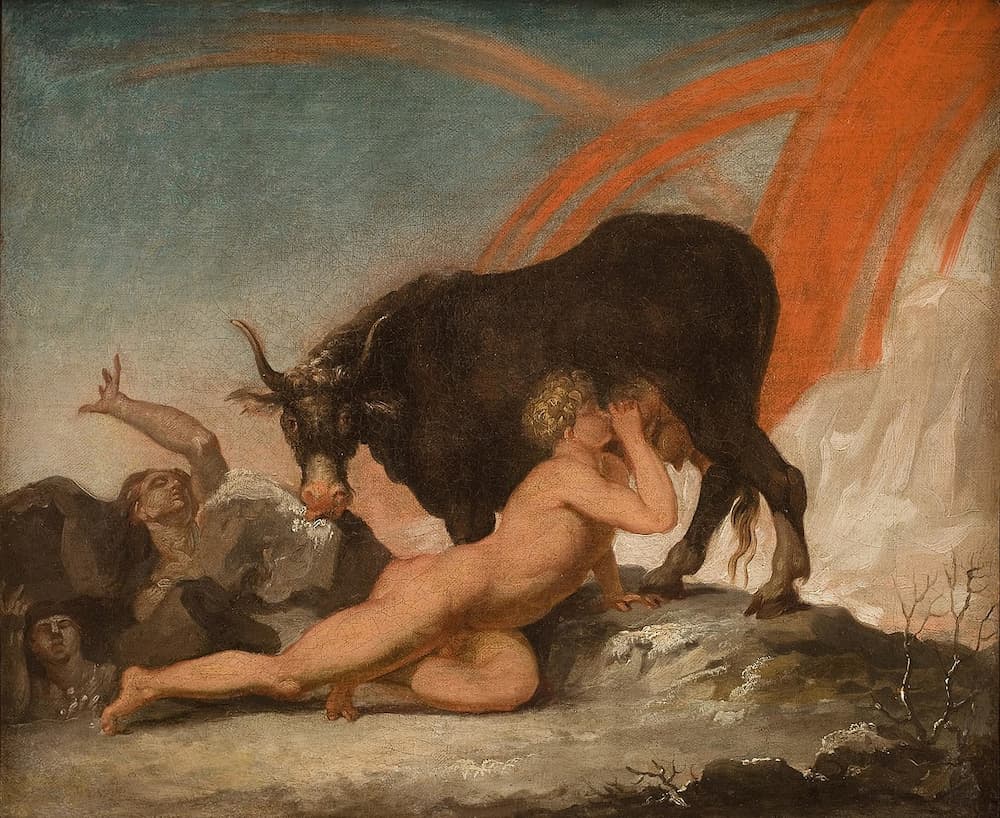These summer weeks have been amazing for stargazing. I’ve moved to the country and I’ve been able to stay in a darker place than in the past, so I could enjoy a much better vault of the sky. While sitting there, I recalled some of the Norse creation myths I had read in a very interesting book1, which introduced me to a stunning and complex mythology.
I want to make a quick recap here of some of the coolest facts I noted down, but I warn you: it will get confused. Norse mythology was passed on orally between generations, and there was no writing among Vikings (runes don’t count, they had a different purpose), so most of the information arrived to us from relatively modern poems written after AD 1000, as Poetic Edda, when Christianization was already in progress.
The Nine Rings Worlds #
First, it must be clear that the Norse cosmology is made of several worlds not physically connected, so it should be impossible to travel among them. That is not totally correct though, because Odin often travels by using the branches of Yggdrasil, the tree which connects all the worlds. Because of that, the tree’s name could mean “Horse of the Terrible One”, which is referred to the one-eyed god. Also, some said that Yggdrasil was an ash tree, which a kind of plant often found in ceremonies, as the ashen faggot from England.
About the different worlds, there wasn’t a detailed directory in any resource. For modern demands, it has been filled a list with nine worlds2:
- Asgard – home of the Æsir gods
- Jotunheim (or Utgard) – home of the evil “giants” called Jötnar
- Alfheim – home of the elves, (never described in any resource)
- Nidavellir – where dwarves lived
- Vanaheim – home of Vanir gods (never described)
- Hel – the underworld
- Muspelheim – a world made of Fire
- Niflheim – a world made of Ice
- Midgard – our world, the only one not part of the “Otherworld”

A scheme of the nine worlds by Henry Wheaton, 1843. It really does not help at all. (via Wikimedia Commons).
So, our entire lives are spent in Midgard, where no god or magical creature lives. Shamans, anyway, using trance, can travel to other worlds. To be honest, there are also a handful of fascinating ways that could make the physical travel possible. According to the sources, moving between worlds should be achievable:
- By walking on the rainbow 🌈
- By diving in certain pools of water 💧
- By walking in the dark 🔦
- Through memorial barrows 💀
- Traversing inaccessible forests or mountains 🏔️
Interestingly, the other worlds don’t have a specific direction (e.g. to the West) – they’re just “far away”. Also, everything is just more extreme in those worlds than in ours: colors are brighter, sounds are louder… We are the boring ones. 🥱
Party Hard. Fight Harder. #
The most important world of the list above is where the Æsir gods live: Asgard. Marvel fans will be familiar with it because of the Thor movies (which, as we already said, is very different from the character depicted in the myths). It is a fortress built around Yggdrasil’s trunk3, and its only access way is the rainbow called Bifrost. Among this pantheon, the main characters were Odin, Thor, Loki, Balder, Tyr, Mimir, and Heimdall.
One of the main fun of the gods was fighting. Thor was the typical example of the “dumb tough guy”, but all of them have stories telling heroic deeds. Among humans, it was important to be a brave warrior to get access to the Valhalla: it was a golden hall with spears instead of beams and shields instead of a roof. The benches at the tables were chest covers. The rules to be welcomed there are not clear, but it seems that a violent death gave more chances. Odin had the last word on the choice, too.
The main foes of the Æsir were the Jötnar, a race of beings always depicted as malevolent. In modern English, their name is mistakenly translated as “giants”, but their appearance was not as the classic huge creatures as the BFG in Roald Dahl’s story: they looked like pretty much like the Æsir – in fact, Loki’s father was a jötunn.
The other gods often mentioned in the sources are the Vanir, who were associated with the concepts of fertility, wisdom, and foresight. A few of them were cited: Frey, Freya, and Njord.
There has been a war between Æsir and Vanir, and there are multiple versions of it. In all of them, there’s an exchange between the two god civilizations: Frey and Freya move to Asgard, and Mimir and Hoenir move to Vanaheim. Also, a common tract is the creation of Kvasir, the wisest living being of all the cosmos.
There are so many Norse myths, but they often differ in some aspects because they’ve been written in different centuries (and, before, they were told orally) and in different countries, so each population of course had its own version.
A Violent Beginning… #
One of my favorite Norse myths is the Creation one – you could say I have a thing for creation myths! So, here is a quick digest.
At the beginning, there was just Ginnungagap, the “yawning abyss”, the Void. Then, Muspelheim and Niflheim appeared, the reigns of Fire and Ice. By crashing, those two created Ymir, the first giant, ancestor of all the Jötnar. From his sweat, other giants were born, and a cow too, named Auðumbla.
By licking a block of ice, the calf slowly freed the first god, Buri (“Father”). He had a son, Bor (“Son”), who had three children with the giantess Bestla. They were named Odin, Vili (“Will”), and Vé (“Holiness”). These gods then killed the giant Ymir and created the world with his body: his blood became the sea and the waterways, his flesh the earth, his bones and the teeth were stones, his hair the grass, his brain became the clouds, and his skull was the vault of the sky. Alas, the flood of blood was so violent that killed all the giants except Bergelmir and his family.
The three brothers decided that the Jötnar had to live in the most outer part of the universe (Utgard)4 and Midgard (still to be created) had to be for humans. At last, Asgard was created.

Ymir is fed by Auðumbla, which is licking and freeing Buri from the ice. Painting by Nicolai Abildgaard, circa 1777. (via Wikimedia Commons)
Then, man was made. This is a much less violent story, but shows that gods are capable of empathy: Odin found stranded wooden pieces, so he shaped them manlike, and blew on them, giving them life. Vili, then, gifted them with emotions and wit; finally, Vé gave them the five senses. They were then dressed and brought to Midgard. The first to humans were called Ask (“ash tree”) and Embla.
It is a nice story, but most of the myths are quite rude. There are lots of characters, who may appear just once and never again, and some long-term hatred occur in several tales. The best, anyway, is kept as final serving.
…and an Even More Brutal End #
The end of the world always fascinated humanity all around the globe. Each population (or religion) has its own version, and so had Norse people. And honestly, it’s a kick-ass conclusion. Like a TV series finale, it even puts the roots for a new potential beginning, for a new season! Let’s make it clear: Armageddon is for boys, Ragnarök is for men.
It will start with the Fimbulwinter, the “Great Winter”: three cold seasons with no summer between.5 Human bonds will dissolve, chaos will reign: brothers, fathers, and sons will kill each other. The wolves that were chasing the moon and sun, finally will get them and swallow them. There will be an earthquake so violent that it will make collapse everything – even Yggdrasil will be shaken. Heimdall, the guardian of Asgard, will play his mighty horn to alert the gods, and Odin will ask advice to Mimir’s head – but he won’t like his reply.
Jörmungandr, a serpent so long that it can encircle the whole world Midgard, will rise from the water, causing floods that will engulf what had not been destroyed yet.
Fenrir, the wolf father of the one who ate the sun, will break free from his chains and will devour everything before him.

Now, grab the popcorns. 🍿
A ship made of nails from human corpses, called Naglfar, will rise from the ocean where it was lying; it will be full of giants, and headed by Loki. From Muspelheim, Fire giants will charge over the Bifrost, lead by Surt, who will have a sword brighter than the (now consumed) sun; they will force the Æsir to leave Asgard. The battle will converge in a plain called Vigrid: on a side there will be Loki, Fenrir, and all the Jötnar – on the other, the gods and the dead from the Valhalla.
Odin will be the first to attack, but Fenrir will slaughter him. Thor and Jörmungandr will face off in a mix of poison and lightning, but eventually the Mighty God will strike his foe with a decisive blow. Anyway, he will be so filled with venom that will fall dead on the ground after just nine steps.
Heimdall and Loki will kill each other. Tyr will do the same with the wolf Garm, and so Frey with Surt. In the meanwhile, the flames will have swallowed the world, which will sink in the water like a shapeless mass. The silence and the void of Ginnungagap will be restored.
Armageddon is for boys, Ragnarök is for men.
But then…
Earth will arise from the water again, lush. Two sons of Odin, Vidar and Vali, survived, and so Magni and Modi, sons of Thor. Balder and Hod will be there too, still alive. Then, two humans who hid in a tree trunk will come out to repopulate the world – they will be called Lif (“Life”) and Lifthrasir (“The one who fights after the life”). Also, the daughter of the sun will come and take its place. And then, gods will find golden pieces of a game they enjoyed a long, long time before. Finally, a new almighty god will appear in the sky to bring justice and righteousness.
And that’s it, that was pretty much the description of the Ragnarök, but as always different sources have slightly diverse versions. That final image of the golden game pieces is… Astonishing, at least, for a legend from centuries ago! It would fit perfectly the Lost finale, or Westworld’s – so mysterious and symbolic.
This was just a brief and confusing introduction to one of my personal favorite pantheon: each character is not “just there”, but has his or her motivations, alliances and enemies. I’ll surely post more Norse myths or brief stories in the future: there’s so much to tell, and some tales are very entertaining. We didn’t even talk about Thor’s goat-driven chariot!
-
The Viking Spirit by Daniel McCoy, which I totally recommend because it is fast, interesting and full of curiosities. Check also the website in the link, it contains many fascinating information. ↩︎
-
Nine is a recurring number in Norse mythology, as three and its multiples. ↩︎
-
Similarly, actual Viking houses were built with a central, tall log. ↩︎
-
The concept of inside (Innangard) and outside (Utangard) can be a comparable to good and bad, or order and chaos. Note that the Jötnar are confined to the outer part of the cosmos. ↩︎
-
Well, climate change isn’t helping. 👀 ↩︎